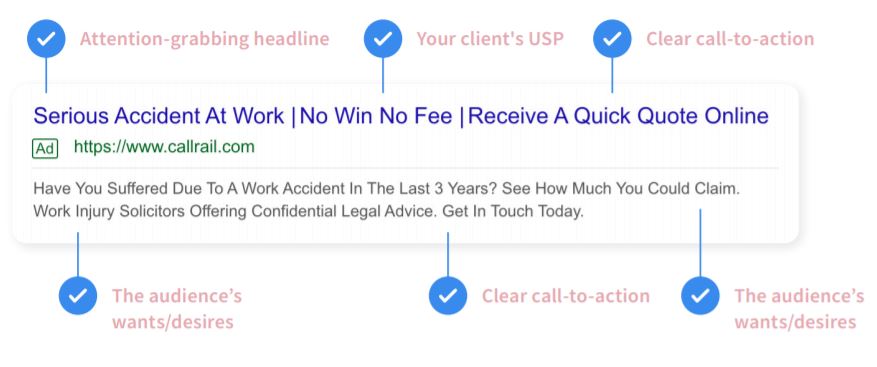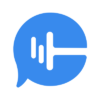Last year, consumers spent $861.12 billion with online merchants in the United States alone – a jaw-dropping increase of 44.0% year over year.
Compare that to a 15.1% increase in 2019. That percentage nearly tripled over the course of a year!
With those numbers in mind for a little perspective, it should come as no surprise that as the competition among online retailers increased, so did the competition for PPC and online advertising.
Agencies are under intense pressure to deliver results and return on investment (ROI) for their clients.
The good news?
With the right strategy in place, small businesses can stand toe-to-toe with the big brands when it comes to PPC competition.
Some of the most common PPC goals and key performance indicators (KPIs) used to gauge the success of a campaign include:
- Total clicks
- Click-through rate
- Cost per click
- Lead generation
- Cost per lead
- Cost per conversion
Most clients aren’t interested in vanity metrics like clicks anymore. Instead, they’re favoring bottom-of-funnel metrics such as inbound calls and qualified leads.
This quick four-step strategy will provide proven methods to help you deliver on those expectations and drive impactful results.
Quick Win #1: Lead Generation Ad Copy
It’s impossible to overstate the importance of ad copy.
In many cases, your ad copy is the first introduction a prospect has to your client’s business – and a good first impression is everything.
Space for ad copy is limited, which means you only have a handful of words that need to make a big impact.
Audit your ad copy with this checklist for every project:
- Attention-grabbing headline.
- Your client’s unique selling proposition (USP).
- The needs and desires of your audience.
- A clear call to action.
Let’s take a look at an example that an agency crafted for a client in the legal sector:

Even though space is limited, every necessity on the checklist has been met.
Incorporating ad copywriting best practices is a surefire way to up your PPC game and generate leads.
Quick Win #2: Retargeting Call Campaigns
The beauty of this method?
You’re maximizing your client’s budget by serving ads to an audience that has already expressed interest but didn’t follow through.
This gives you a higher chance to convert, as opposed to displaying ads to random website users who may or may not be interested.
Here are some useful tips to consider when planning your retargeting campaign:
Focus on People Who View Middle-of-Funnel & Bottom-of-Funnel Content
Targeting the prospects in these categories who didn’t convert helps you identify and engage with an audience that just needs a little nudge rather than a full brand-awareness marketing pitch.
Middle-of-funnel content refers to assets that are directed toward leads who have already engaged with a brand in some capacity. The goal is to educate and entertain while nurturing prospects and building conversion intent.
Examples of middle-of-the-funnel campaigns can include:
- Email marketing
- Content marketing
- Webinars
- Online courses
Bottom-of-funnel content refers to assets that persuade a prospect to take that final last step and make a purchase. This content is designed to inspire confidence in a buyer, highlight the brand’s superiority over competitors, and finalize the deal.
Examples of bottom-of-funnel channels and methods can include:
- Customer relationship management (CRM)
- Case studies
- Reports
- User communities
If these are low-traffic pages and you need quick results, you can test an existing audience. Or, alternatively, you can start building an audience for the pages with the highest traffic while you wait for the other audience to develop.
Create ‘Call-Only’ Retargeting Ads
Call-only ad retargeting shows ads to prospects who have called your client’s company as opposed to prospects who have visited the website but not communicated with a representative.
This niche has already been in direct contact with the company as is more likely to convert.
Some tips to increase your call-only ad retargeting success rate:
- Segment your audience based on keywords and search terms, geographic location, and callers versus website visitors. You’ll want to adapt your strategies based on the audience you are focusing on.
- Define the goals and KPIs of a successful campaign. Most agencies typically focus on one of two primary objectives: brand awareness and conversions.
- Test the effectiveness of your campaigns once they’ve been implemented. Tools such as A/B testing, call tracking, and other analytical data can show you how your client’s prospects are interacting with the business in response to the retargeted campaign.
- Evaluate the results and refine your strategy. If you’ve gathered relevant, useful data, it should help to paint a clear picture of what is working well and what could be improved. Go back and reevaluate the ads themselves if they aren’t meeting your expectations. Is the copy tailored to the correct segmented audience? Could the language be updated to make a bigger impact?
Schedule Ads & Adjust Bidding To Match Your Client’s Business Hours
Ensure that calls are coming in when representatives are available to answer, especially if call-only ad retargeting is part of your strategy.
Speed is everything today.
Did you know 82% of customers rated an immediate response from businesses as “important” or “very important” for marketing or sales-related inquiries. That number rises to 90% for customer support issues.
Based on the expectation of immediate service, it’s not a great first impression to have prospects reaching out to your client outside of business hours and leaving a voicemail, then having to wait until the next business day for a response.
Ideally, you want prospects contacting the business when a real person is able to answer the phone right away and have a conversation with them.
Use Call Quality Reports
Analysis and follow-up are important parts of the process.
Call quality reports (like those from CallRail and other business intelligence tools) can provide valuable insight into how effectively the ads performed, how well the client’s team responded to the prospects reaching out, and where any pain points may be that need to be addressed.
Some of the KPIs you should be tracking as part of the call quality score include:
- Speed: How quickly was the call answered?
- Hold time: How long did prospects have to wait on average?
- Attitude: What was the representative’s overall disposition when speaking to the lead?
- Resolution: Was the issue or question(s) resolved on the first call?
- Audio quality: How clear was the connection?
- Satisfaction: How did the prospect rate their experience in a post-call customer satisfaction survey?
Quick Win #3: Bid Automation
This tool can drastically improve your time management compared to manually balancing your client’s Google Ads budgets.
When bid automation is incorporated into your PPC strategy, you save time and labor by no longer needing to manually divide your budget among keywords with various price points, which is a lengthy, tedious, and imprecise method.
Instead, the automation will choose an optimized combination within the budget that will set you up to maximize the potential return.
However, it’s important to remember that automating the process doesn’t mean it’s a one-and-done step. You still need to monitor regularly for anomalies.
Quick Win #4: Improved Reporting
Understandably, clients want to see the ROI of your campaign efforts.
The best solution is to present the data in a clear, concise, visual report that a client can easily interpret and understand.
By connecting data points from social media, advertising platforms, CRM systems, and other analytical tools, you’ll be able to paint a full and easy-to-read picture of whether the client’s goals and expectations are being met.
With this analytical data, you and your client can discuss the progress that has been made. This is also a good time to zero in on the pain points and strategize how they can be addressed.
At this stage, your client’s end goals for their PPC objectives may also evolve based on the data collected so far.
All of this information is important to circle back and refine the overall strategy.
How CallRail Can Help You Master Your All-Star PPC Strategy
For 10 years, we’ve helped small businesses and the agencies that serve them to optimize their marketing spend and increase valuable leads. Today, we serve more than 175,000 businesses.
Our unique marketing platform delivers business tools to market smarter, drive more quality leads, centralize communications, and convert leads to customers.
We offer reporting tools that are built to sort, filter, and provide insights for calls, texts, chats, and form submissions, allowing you to analyze and understand how your PPC campaigns are performing.
Examples of some of the CallRail reports that can be invaluable for fine-tuning your PPC strategies include:
- Channel attribution to help you understand how PPC campaigns are performing in comparison to other channels.
- Date and time reports to help you schedule your ads and plan your budget.
- “One-at-a-time” call logs to help you improve the quality of your lead generation with high-quality calls.
- Custom tagging reports to help you identify new keywords used by prospects as they speak with a representative on the phone.
CallRail seamlessly fits into existing workflows; integrates with several major marketing and sales platforms, including HubSpot, Facebook, Salesforce, and Google Ads and Analytics; and scales with each customer’s needs as they grow.
We’re ready to help you master PPC no matter what stage you’re in.
If you found this information useful, visit our website and check out our free downloadable guide for a more in-depth look at how these PPC quick wins can help you drive impactful results.
We’re ready to help you master PPC
no matter what stage you’re in.
The opinions expressed in this article are the sponsor's own.



